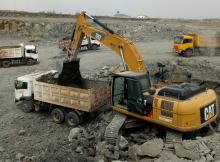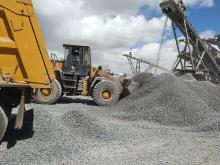The massacre of quarry workers in Kenya in December 2014 could have a big impact on quarrying within the region it took place, writes Shem Oirere.
The massacre of 36 quarry workers in northern Kenya on the morning of Tuesday 2 December 2014 has jolted quarry mining in the 26,474km² Mandera County and threatened to disrupt the pace of construction in the region that has become synonymous with terrorist attacks due to its proximity to war-torn Somalia, the base of al Qaeda-linked militant group, al Shabaab.
Those killed were part of an army of casual quarry workers enlisted by individual quarry owners, some who lease the mines from locals for the production of construction materials. It could not be immediately confirmed who owned the quarry at Koromei or how many other workers were affected by the dawn massacre that jolted the largely semi-arid county located 1,100km from the capital city of Nairobi by road.
The killings, which forced Kenya’s President Uhuru Kenyatta to sack his Interior Cabinet secretary Joseph ole Lenku and triggered the resignation of the country’s police chief David Kimaiyo, were carried out by the al Shabaab militants from Somalia barely 10 days after the same group executed 28 passengers travelling from Mandera to the capital Nairobi. In both cases, the killers separated Muslims from non-Muslims before slaughtering the latter in what the country’s leadership say is an attempt to create religious conflict in the country.
Later on Tuesday 2 December 2014 the militants, who have been battling African Union soldiers deployed to bring stability in Somalia, claimed responsibility for the killing of the quarry workers and warned of more attacks if Kenya does not withdraw its troops, who preceded the deployment of the continental force in the country that has had no stable government since the ousting of former dictator Siad Barre in 1991.
Through their spokesman Sheikh Ali Mohamud Rage, the Islamic extremists castigated the Kenyan government for carrying out a raid on their bases inside Somalia after the killing of the 28 passengers 10 days before the quarry workers were killed. Kenya’s Deputy President William Ruto had said after the killing of the 28 bus passengers that the killers “never lived to celebrate their macabre act.”
Following the killings at the quarry near Koromei, workers in other quarries have fled their work stations with more seeking government help to be evacuated from the county because they are non-Muslims and could be a target of a similar attack.
“We will be dead if nobody rescues us. Local residents came today (Tuesday) morning and demanded we pay the debts we had from them, only for them to leave us behind. We are alone and some of us have no money since we gave out everything,” said Mr John Kung’u, a father of five, according to a report in the Nairobi-based The Standard on 2 December 2014.
“We received reports today that other quarry miners were shot dead last night and we fear our camp will be next. There are no security officers, despite our employer promising to bring armed security. We have been abandoned,” said Kung’u.
According to the Standard, many of the quarry miners are from non-Muslim counties of Kiambu, Nyeri, Kisumu, Busia and other parts of western Kenya.
Earlier, Mandera County Senator Billow Kerrow had confirmed the fears of non-Mandera residents in the county who are the targets of the Islamic extremists when he said: “These terrorists want to create chaos in the country by creating divisions between Muslims and Christians. They can be so emboldened because they are meeting no resistance and decide to take over a town.”
Apart from the quarry workers, scores of government employees, especially teachers and health workers, have fled their Mandera homes and sought refuge at a military camp in the county awaiting evacuation to their counties of origin.
The killing of the quarry miners came at a time when the National Environmental Management Authority (Nema) had launched a rehabilitation programme of exhausted quarries and unveiled plans to rein in haphazard quarry activities across the county.
Nema County Director Joseph Kopejo recently told journalists the level of environmental degradation from the uncontrolled quarry mining is too high and should be controlled through enforcement of the law and sensitisation of quarry workers and owners. He attributed the increase in quarry operations to “high demand for building blocks because the county government is putting up many buildings.”
“Due to increased mining activities, Nema is putting up new regulations that will protect animals and people from the danger of falling in open pits,” Kopejo was quoted saying in August. He blamed illegal miners working in unlicensed areas for the environmental degradation.
“We are going to be very strict on quarry owners who do not comply with environmental impact assessment standards. We should protect our environment for future and current generations,” he said, adding “It is a prerequisite that quarries are fenced before commencing work and advisory bill posts erected to warn on possible dangers,” he said.
Mandera County government has listed quarrying and sand harvesting as the main mining activities in the region.
According to Mandera County Governor Ali Ibrahim Roba “the county has an abundance of limestone deposits (specifically in Elwak and Rhamu towns) from which cement can be manufactured.”
However, he has warned previously that quarrying is among the activities that have “degraded environment.”









